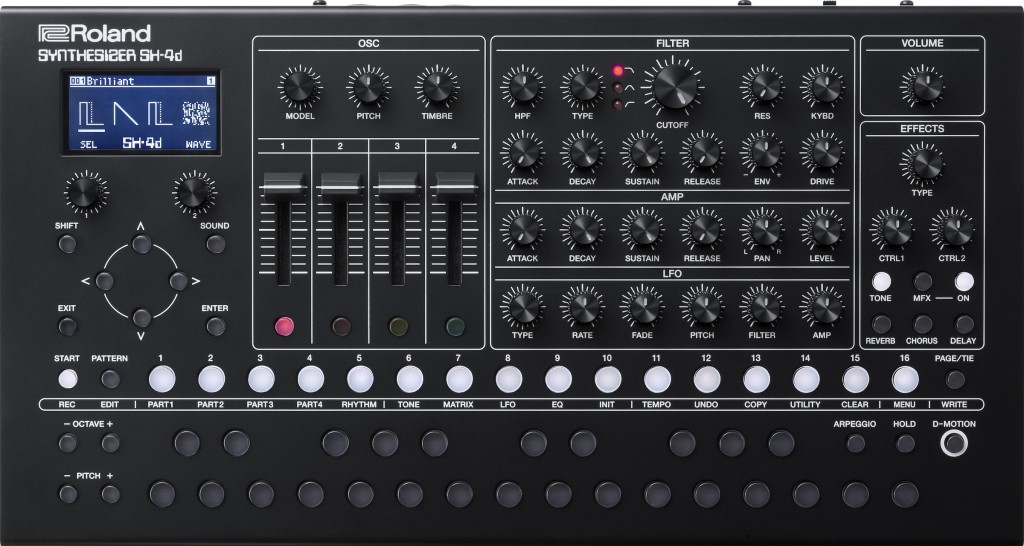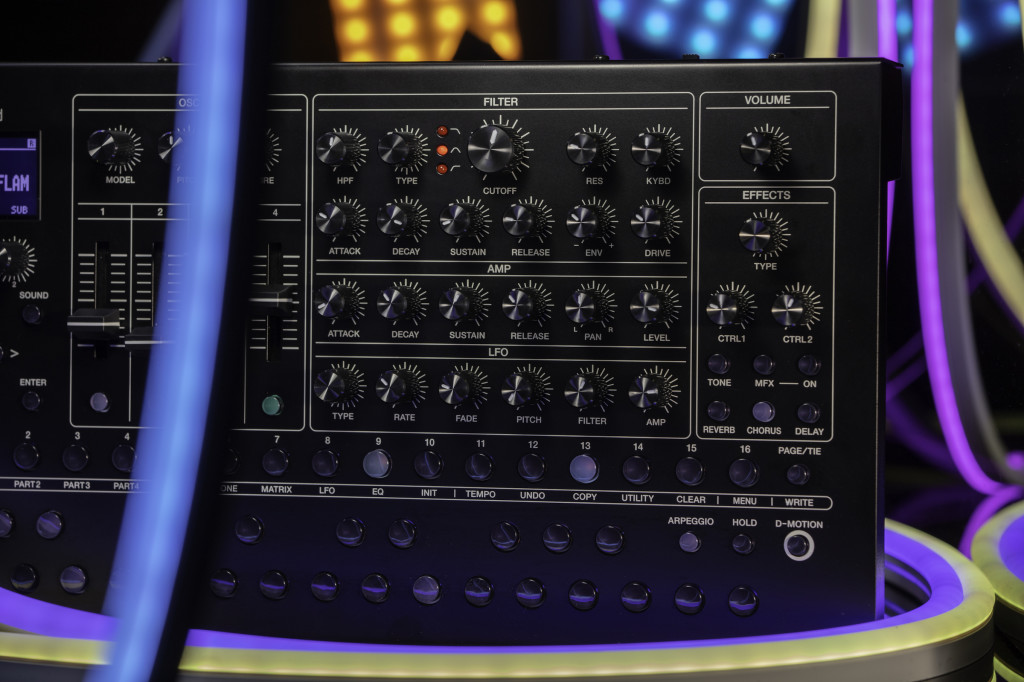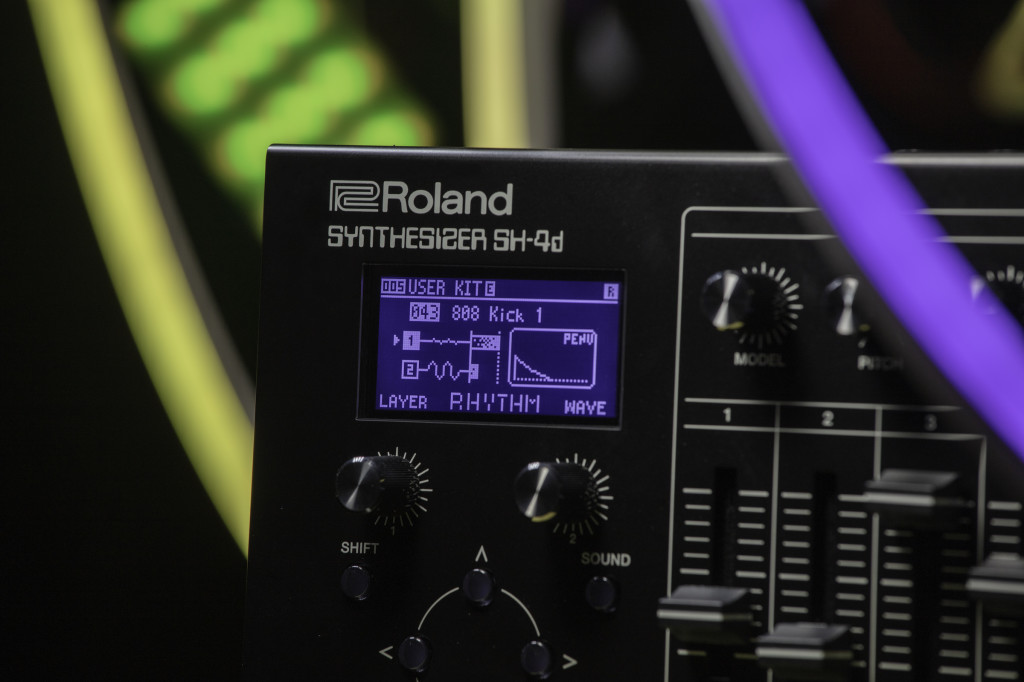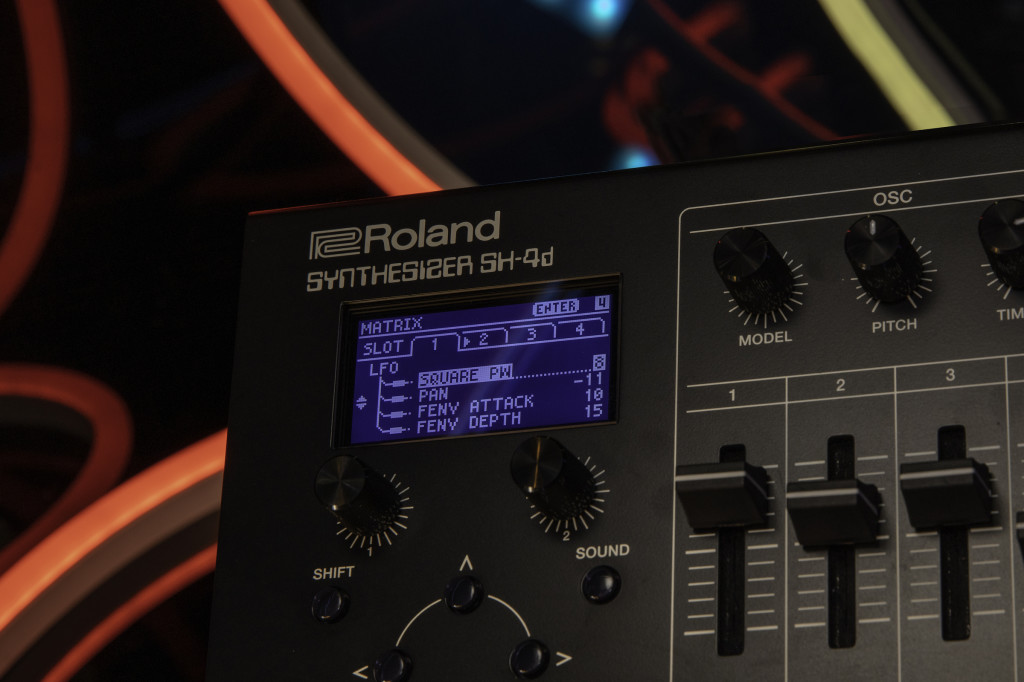Roland has built one packed instrument to celebrate 50 years of the company’s synths. The SH-4d sports eleven synth oscillator models in one box – from SH-101 and JUNO-106 to new cross FM and wavetable synths. But it’s still hands-on, battery-powered, and costs US$649. And there’s a twist, literally: D-MOTION motion control means you can pick up the synth and play it by moving it around.
https://www.roland.com/global/products/sh-4d/
[this article uses affiliate links for resellers to help support CDM’s publication]
11, 11, 11 polysynths in one (with a drum synth)
It’s been 50 years since Roland unveiled its first synth, the SH-1000. The SH-4d is a bit like a greatest-hits box to mark the occasion, all in a compact desktop unit. That’s in contrast to some past years when Roland offered up bulkier, more expensive workstation keyboards instead. (Presumably that lowercase “d” is for “desktop.”)
So this unit brings together models of the SH-101 and JUNO-106, its own original “vintage” SH-4d and SH-3D voices, wavetable and Drawing modes (for custom-drawn wavetables), and modes for edgier cross FM, Ring [modulation], Sync [hard sync], and in case you run out of sounds, a Chord mode and PCM base full of still more. The PCM stuff has 50-odd wavetables and you can stack four parts at once – which actually makes this a lot like instruments like the JD-800 and 90s XV series, from a sound design standpoint.
Oh, and there’s a drum synth with shapeable parameters and still more layering. That means you can make your own nice, layered kick.
These all are derived from Zen-Core stuff – the 60 notes of polyphony and the price should tell you that – so don’t put your ACB-based instruments up for sale just yet. These are new versions, though, the Zen-Core stuff was nice enough, and the amount of flexibility here looks significant.

What’s nice about the approach of the SH-4d is that you get this diversity without a chaotic approach to what to control. The different models shift the OSC section, but everything else stays consistent. (That is, strong as the SYSTEM-1/SYSTEM-8 were as synths, you don’t have a different control layout when you switch instrument models.) The design feels inspired by the directness of early SH synths and their faders. You get four faders with mute toggles, ideal for the thickly layered voices here. The SH-4d is the primary 4-oscillator model; the SH-3D (cap choices theirs) makes the fourth oscillator an LFO.
Maybe the biggest news sound-wise here – apart from new things like a ring mod mode – is a new ladder filter model Roland has built just for this unit, complete with drive.
Watch the video for a nice walkthrough of each voice. I think it’s probably fairly vanilla as a sound demo, but think of it as a visual manual.

Roland is back – and so are D-THINGS!
I know what commenters say. To them, a return to Roland history would be something analog – apparently because they really don’t know Roland history that well. Roland and founder Mr. K always advocated digital tech; the word “computer” is even literally screenprinted on some of the devices you see people trolling about.
No, the Sh-4D looks as Roland as something can get – in a good way. It’s got a bunch of functionality crammed into one package. It’s aggressively priced for musicians. It’s very hands-on, with buttons, faders, and knobs. And it’s even got something a bit weird – D-MOTION.
So in fact, when they say record-able X/Y control, they don’t mean a pad or IR beam (a la D-BEAM). You actually pick the synth up and move it around. Do you want to do that? I don’t know. I don’t care. It’s weird Roland, and weird Roland, we missed you. Welcome back. Happy 50th.
Adding a ton of controls comes in the tradition of their best, most playable instruments (SYSTEM-100, SH-101, JUNO, JUPITER, JD-800, SH-201, GAIA SH-01, SYSTEM-8). And it’s in contrast to some designs that lack hands-on control and tend to hold up less as a result.
So on paper, this is a strong entry. I’m keen to get one in my hands to see how the thing actually feels and sounds. (I don’t think you should judge sound based on product videos.) I expect we’ll get that soon.

Pricing and availability
These are coming to the USA in March at US$649.99; we’re waiting to hear worldwide availability.
Full specs
There’s a lot here – massively polyphonic for the price, and 5-part multi-timbral:
User Memory
Sound Patch: 256
Pattern: 128OSC MODEL
SH-4d
SH-3D [these are both “vintage” virtual analog]
SYNC
SH-101
JUNO-106
Cross FM [think 2-op FM]
RING
WAVETABLE
CHORD
DRAWING
PCM
RHYTHM [fixed to the RHYTHM part]Maximum Polyphony
60 voices (varies according to the sound generator load)
Parts
5 parts (Tone part: 4, Rhythm part: 1)
Dedicated Filter, Amp, and LFO sections.
That’s important to clarify:
- One LFO per part – except the SH-3D, which adds a second LFO
- One amp envelope per part
- One filter envelope per part
Matrix section, which routes LFO or envelope generator to parameters inside your Model (so you’re not limited to using the two envelope generators per part only for amp and filter).

And there’s an effects section, which also looks fairly Zen-Core-ish:
Multi-Effects: 5 systems, 93 types
Reverb: 9 types
Chorus: 5 types
Delay: 5 types
Master Effect: 93 types
Master EQ / Comp
There’s an arpeggiator with five modes. The Visual Arpeggio “shapes note patterns via fun interactive displays.” Translation: there’s a bouncing ball with animation, a little like having a simple Max for Live patch in there.
And there’s a 5-part sequencer, with 64 steps, sub-steps, flam, and probability. That in turn has dedicated step buttons, so you get both keyboard and x0x step buttons.
I/O:
Stereo 1/4″ phones jack
1/4″ output jacks
Mix input (stereo minijack)
External clock in (minijack mono)
MIDI in and out
USB-C which doubles as a MIDI and 12-channel audio interface
Here’s the breakdown of what’s accessible from your computer as discrete channels when you connect via USB:
DIGITAL OUTPUTS
1/2 – Master Output
3/4 – Part One Output
5/6 – Part Two Output
7/8 – Part Three Output
9/10 – Part Four Output
11/12 – Rhythm Output

Power:
Run on AA batteries or a USB-C phone charger – for up to four hours, Roland says. Try that with your analog synth.
It’s all impressive. I’m not giving up my TR-8S drum machine any time soon. But it occurs that this single box – even though it doesn’t say “MC” on it – has a lot more in common with the 90s and 2000s MC series. It’s an all-in-one with a bunch of features and instruments and effects. And I think that’ll be a big hit.
Consider that to get this setup in the original AIRA lineup, you’d be getting a TR-8 and a SYSTEM-1 (or later SYSTEM-8), minimum. And this one has some of the best-looking bits of recent Roland gear.
The only curious omission here is that there’s nothing on the software or Roland Cloud side, but I wouldn’t be surprised if we see at least an editor down the road. Those have had a tendency to lag.
And if you really wanted an SH-1000 for some reason, there are a few on the used market.
Carl Craig chose this instead:
Stay tuned for more on this one. Let us know what you think and if you’ve got any questions.
Addendum: once and future Roland. A few readers noted similarity to Roland gear past. Like the SH-32, this is a 4-part layered polysynth based on wavetables with oscillator sync and fader control of the parts, plus multi-effects. The SH-32 had something called “Wave Acceleration Synthesis” to accomplish the task, and even an arp and drum map. The SH-4d is far deeper than that original concept, though, and shares some design philosophy with the 1998 MC-505 – namely, it’s really a drum machine and drum sequencer when you want it to be, too.
Everything new Roland does is connected to something it did in the past. Just don’t get too lost in comparison, other than for nostalgia’s sake – the SH-4d’s sound and attractive layout are a far cry from the older gear and their somewhat chaotic (sorry) front panels.
Video demos, discussion and reviews
What the OSC models sound like raw (from Roland):
Japanese instruments need Japanese reviews, too!
Sonic State’s Sonic Lab includes a chat with Roland directly: